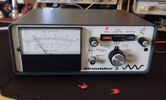I just skimmed through the video, but it looks like his notch filter caps are bad. That's why at the end of his video, the meter won't adjust to the far left.
You need 2 things to calibrate these Sinadders properly:
1 - A very accurate tone (signal) generator, capable of 1KHz and 2KHz sinwave tones.
2 - "Matched" notch filter capacitors in the Sinadder that are still in spec.
When I did mine, I purchased 10 of the caps I needed. Then I tested them all on a capacitor tester to find the 2 x caps with the closest values. As soon as I replaced them, everything aligned perfectly.
FYI - In my Sinadder 3, the required notch filter caps were 10nF (.01uf) Polyester caps.
Great success.
I happen to have a picture of the offending notch filter caps - see the attached picture of a happy Sinadder 3 @12dB SINAD.
Attachments
Last edited:


